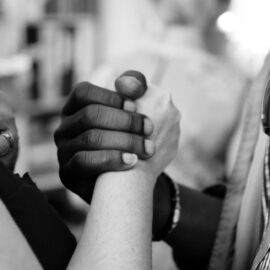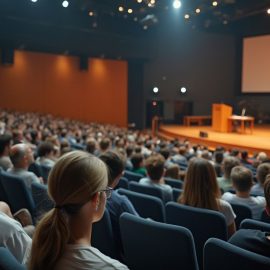

This article gives you a glimpse of what you can learn with Shortform. Shortform has the world’s best guides to 1000+ nonfiction books, plus other resources to help you accelerate your learning.
Want to learn faster and get smarter? Sign up for a free trial here .
What are the most common student challenges that are faced today? Why are students being silenced in schools that are difficult to get accepted into?
Whether they’re in elementary school or college, students don’t have it easy. Some areas students may struggle with include mental health, social inequality, and a lack of academic preparedness, all of which can be brought on by flawed school systems.
Below we’ll look at some of the major student challenges that need to be addressed to make students’ lives easier.
1. AP Courses Cause Stress
Two of the biggest student challenges are caused by AP (Advanced Placement) courses. We’ll look into the first one here. As AP course offerings expand, high school students are feeling increasing pressure to take them, in order to be competitive in the college application process. Psychologists and high school students themselves have pointed to the potential mental health effects this can have on teenagers.
When AP courses were a new thing, only the most well-prepared students could take them. In an effort to make them more accessible to everyone, restrictions have been lifted on who can take them and how many classes a student can take. Many students, feeling pressure to excel above their classmates, will take 12-15 AP classes throughout their high school career, beginning as early as ninth grade. Since these classes are more time-consuming than regular high school classes, students experience increased levels of stress and anxiety and get fewer hours of sleep.
In an opinion piece, two Texas high school students penned a detailed critique about the effects the AP program has on students’ mental health, calling for a cap on the number of AP courses any one student can take. They say the AP program motivates students and allows them to explore their passions, but it may not be worth the struggle.
A proposed solution to this problem would be to institute caps on the maximum number of AP classes a student can take.
2. AP Courses Don’t Prepare Students for College
Another challenge students are facing in AP programs is that the courses really don’t have college-level standards. This means when a student takes one of these classes and gets credit for the college equivalent, they can be put at a disadvantage when they reach upper-level college classes. And teachers don’t have control over the curriculum—they’re given the curriculum and expected to teach it in a way that gets students to pass the exam in the end.
Former Boston College Professor John Tierney, who has also taught high school AP courses, calls AP classes a “scam” saying “The AP classroom is where intellectual curiosity goes to die.” By this, he means that teachers have such a rigid structure and so much material to cover that they can’t possibly delve into deeper learning and critical thinking exercises. This is in contrast to college courses, where professors have the freedom to design their own curriculum and can focus on deeper exploration of the material, rather than just “teaching to the test.” Psychology Professor Peter Gray agrees, calling AP courses a “racket.” Like Tierney, he argues that, although the College Board is technically a nonprofit, it’s run like a corporation, with an emphasis on profit, and this dilutes the value of the program.
Tierney also points to the lack of criteria for taking the courses, arguing that because they’re open to anyone, many unprepared students take them. He believes that about two-thirds of the students in his AP classes shouldn’t be there. Not only does the lack of criteria set those students up for failure, as mentioned in the previous section, but it drags down the whole class, as the teacher has to spend time trying to get those students up to par.
In this case, both Tierney and Gray’s proposed solution would be to abolish the program altogether, and in the meantime, they advise parents and students to opt out.
3. Selective Admissions Criteria Put Pressure on Students
Now that we know how AP courses fail to prepare students for higher education, let’s look at the challenges students face when trying to get into elite schools or are currently attending them.
According to Excellent Sheep by William Deresiewicz, elite schools use strict admissions criteria because they stay in business by marketing themselves as highly selective. A school is considered highly selective if it only accepts a small percentage of its applicants, and usually these schools rank high because they attract upper-class students.
Let’s explore how these selective admissions criteria hurt students.
Intense Pressure Harms Prospective Students
Highly selective criteria harm students who are slated to attend elite schools. Deresiewicz claims that as students prepare to meet highly selective criteria, they feel intense pressure to prioritize achievement over experiences that build self-insight. This takes a toll on their mental health.
The author criticizes parents for pressuring their children as early as middle school to be perfect so they’re prepared to meet selective admissions criteria. Parents pack their children’s schedules with extracurriculars that strengthen their resumés. They pressure their children to perfect their schoolwork and prepare for tests instead of developing hobbies that nurture self-insight. As a result, students have little free time, experience intense stress, and develop a fear of failure.
Admitted Students Become Fearful Followers
Even after students are admitted to US elite colleges and universities, the legacy of selective criteria continues to harm them. Deresciewicz argues that college students continue to prioritize achievement over self-insight. This emphasis further degrades their mental health and makes them afraid to pursue their own interests.
Let’s examine a couple of reasons why students at elite colleges continue to prioritize achievement over self-insight.
- Students at elite colleges feel the need to prove they belong because after they’re admitted, they realize their peers are equally as exceptional as they are. To prove their worth, they compete with their peers: They pursue experiences that make them appear more accomplished (such as multiple extracurriculars) instead of experiences with peers that develop self-insight (such as intellectual discussions over mealtime).
- Elite schools make little effort to deprogram students’ perfectionism. Students sign up for classes they think will be easy and avoid classes and majors that would carry a risk of failure. To them, classes and majors that prioritize career development (such as finance) seem like a safer choice. As a result, many students miss out on the benefits of liberal arts, such as developing their self-insight and their capacity to uphold democracy.
4. Selective Admissions Criteria Perpetuate Social Inequality
According to Excellent Sheep, elite schools’ criteria are so selective and narrowly defined that mostly only upper-class students have the means to meet them. He argues that this exclusion of non-elite students perpetuates social inequality.
Admissions teams consider the following factors, each of which privileges upper-class students:
Standardized test scores. Admissions teams rely on these scores as a measure of intelligence, but the author cites evidence that standardized test scores correlate with family income instead of intelligence. This correlation reflects the fact that wealthy families can afford to access supports that boost their students’ scores, such as well-funded schools, test preparation courses, and tutors.
Leadership experience. The evidence admissions officers use to measure a student’s leadership potential reflects a bias toward leadership experiences wealthy students can access (such as service trips) over those of many lower-income students (such as providing childcare for siblings).
Extracurriculars. Elite schools prefer students who engage in many extracurricular activities, believing this indicates well-roundedness. However, these criteria privilege upper-class students, who are more likely to attend well-funded schools. Well-funded schools offer many extracurriculars such as sports and clubs.
Social identities. Elite colleges show a preference for students with identities associated with wealth and power, including legacy students (children of alumni). This is because these children and their families are more likely to pay full tuition and later become donors.
Why the Exclusion of Non-Elite Students Perpetuates Social Inequality
The exclusion of non-elite students through these high, narrow criteria negatively impacts society. Specifically, Deresiewicz argues that elite schools’ exclusive admissions criteria stall social mobility. He offers two main reasons for this.
First, selective criteria that exclude non-elite students reduce their access to leadership positions. The author notes that attending an elite college opens doors for careers in political leadership. This means fewer people from lower-class backgrounds end up in positions that provide them with a platform for increasing social mobility.
A second way elite schools’ admissions criteria stall social mobility is by limiting students’ opportunities for collaboration across social classes. Democracy thrives when people collaborate to envision and fight for social change. Because elite colleges’ student bodies are majority upper class, there are few opportunities for students from various social classes to learn how to collaborate.
5. Colleges Silence the Voices of Students and Teachers
The last challenge students have to deal with is being silenced in the classroom, thus not being exposed to diverse viewpoints that reflect real life. The corporatization of university life, the interests of university administrators, and the growing fragility and entitlement of today’s students all combine to create an atmosphere on campus that is highly threatening to academic freedom.
The Coddling of the American Mind by Greg Lukianoff and Jonathan Haidt says that colleges increasingly fear being sued by students who claim to have been offended by something a student or professor said to them or by something they may have been assigned in class, administrators have promulgated onerous campus “speech codes” that define what ideas and modes of expression are and are not acceptable.
These codes are deeply damaging to free speech on campus and frequently lead to instances of overreaction to and overregulation of ideas, and affect students’ education by censoring real issues.
Teaching in Fear
Professors now teach in an atmosphere of intimidation, in which using the wrong term or assigning “problematic” work for students to analyze can lead to social sanction from fellow faculty; student boycotts of one’s class; and disciplinary action by the university, up to and including dismissal. This leads to censorship in education that ultimately fails the students because they’re not being exposed to new ideas and experiences that broaden their minds.
To avoid running afoul of this intolerant atmosphere or having a biased report filed against them by a student, professors tiptoe around topics that are likely to lead to such controversies. In law schools, for example, professors report being unable to teach topics like sexual assault law. This only serves to impoverish the students intellectually, while ultimately harming the survivors of sexual assaults themselves.
Another example deals with critical race theory being taught in K-12 schools in America. Critical race theory is the idea that racism is a social construct embedded in legal systems and policies, perpetuating discrimination in systems that are meant to be exclusive. However, many lawmakers have sought to ban critical race theory from being taught in schools, believing it’s “anti-American” and promotes villainizing White people. CRT education opens up an honest conversation about racism in America. However, with lawmakers attempting to silence teachers who are willing to talk about it, students don’t have the opportunity to confront racial realities and change them.
Final Words
These challenges faced by students in all education levels don’t prepare them for the real world. As they graduate high school or college, many will be dealing with mental health issues and lack proper knowledge about societal problems. To fix this, officials need to take a close look at the flawed school systems, and students should stand up for their rights in the classroom.
Are there any other student challenges that we missed? Let us know in the comments below!

Want to fast-track your learning? With Shortform, you’ll gain insights you won't find anywhere else .
Here's what you’ll get when you sign up for Shortform :
- Complicated ideas explained in simple and concise ways
- Smart analysis that connects what you’re reading to other key concepts
- Writing with zero fluff because we know how important your time is






